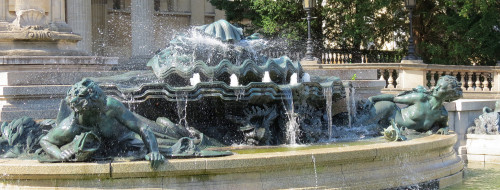
From the Cathedral by College Green, at the heart of Bristol, Park Street climbs elegantly and picturesquely up the hill to the grand Wills Tower of the University, and carrying on, becomes Queen’s Road, which then splits in front of the grand building called the Victoria Rooms. In front of this is the Fountain. It is in fact the centrepiece of something of a collection of sculpture, for there is a statue of King Edward VII looking over the fountain, two bronze lions not particularly noticeable under the trees flanking the Victoria Rooms, and on the pediment above, a fine Grecian relief sculpture by M. L. Watson. Across the road is a further statue, commemorating the Boer War, and more or less (less actually) at right angles to the Victoria Rooms is the Royal West of England Academy of Art building, with much figural sculpture of its own. But here we are concerned with the Fountain.
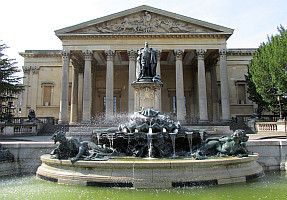 The Fountain, with Bristol Rooms behind, and the statue of Edward VII.
The Fountain, with Bristol Rooms behind, and the statue of Edward VII.
The Fountain is made of pale stone, with the bronze sculpture by the sculptor P. F. Poole; A. E. Rickards was the architect. While the fountain is not particularly associated with the Edward VII statue (also by P. F. Poole), its position in front of that statue, and indeed in front of the noble portico of the Victoria Rooms, meant that a tall fountain would not have worked aesthetically. Hence we have two reclining figures, over life-size, to the sides, but in the centre, instead of some apex with a further figure or tall series of cascades, there are broad, low shells from which the water bubbles and falls. The centre therefore does not dominate, and the side figures are given extra prominence by being somewhat forward of the central shells. Yet as a design, the fountain works well, firstly practically, because the lowness to not compete with what is behind is a good thing, and secondly because the proportion of height to width overall is similar to that of a pediment, somewhat echoing the larger pediment of the building behind and above.
Views of Poole's Triton and Mermaid statues.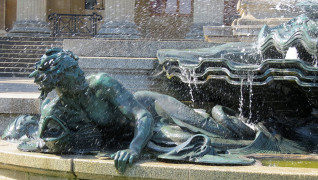
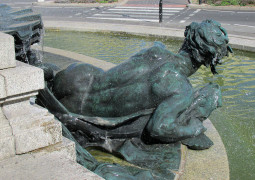
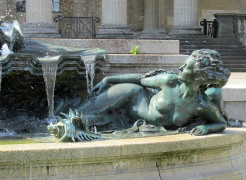
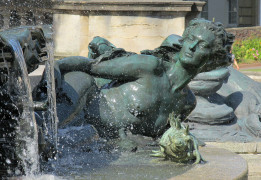
The beauty of the fountain, though, becomes apparent as we go near, and lies in the excellence of the figures and the accompanying creatures and plants. The principle figures are a Triton and Mermaid, he rather aged and muscular in a gnarled, old oak-tree sort of way, she young, full-breasted and wide hipped. They are of the twin-tailed type, with the lower limbs like thighs down to knee level, then curling round to long fishy tails, the effect of this being to give a natural human proportion to the figures. For lots more of such creatures, and a note on the different varieties, see the mermaid page and the merman page. The male figure has particularly weedlike strands of hair, with patches of seaweed, but also notable as we walk around the fountain is the modelling of his back, a sensitive study of the masculine torso. For the mermaid, it is the pose of the head and the combination of voluptuous femininity with an angular boniness to the arms which attracts attention.
Sculture of octopus, sealion, turtle and one of the fish.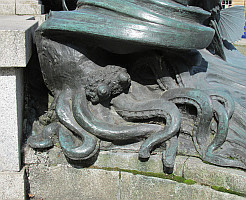
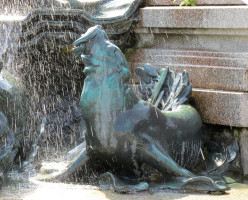
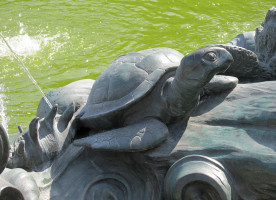
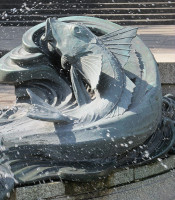
Now to the other elements of the fountain. Most obvious from the front are the spiny seashells, the heaps of different types of seaweed, and the bony fishes writhing and gasping amongst the other things: one of them is actually being leaned on by the Triton, who grips the fin of the hapless sea-creature (for lots more fish sculpture, see this page). As we go round, though, we see other animals, most notably a large sealion or seal eating a fish, behind the Mermaid. Statues of seals are really rather rare in British sculpture – see this page. Much smaller, but more prominent by virtue of his raised head, is a small statue of a sea-turtle, bony and a little sad looking (see this page for more turtle sculpture). A particular treat is round towards the back, where lurking low down is an octopus. If seal statues are rare, octopus statues are vanishingly so, and this is the only one I have come across from all of the Victorian and Edwardian sculpture I have yet seen. Bristol should be proud of it.
General view of the back of the Fountain, and details of seaweed.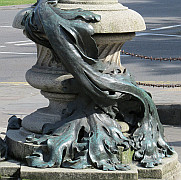
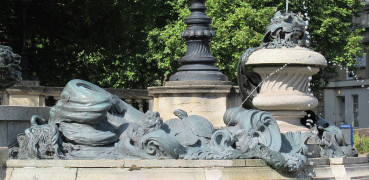
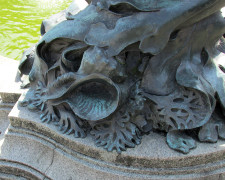
These naturalistic animals, shells, and the seaweed, which includes most of the types we are familiar with from British beaches, show the sculptor, P. F. Poole, as having a sensitive eye for nature and a consummate skill in sculpting it.
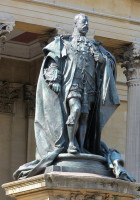
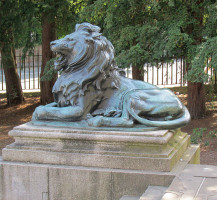 Statue of Edward VII, and a snarling lion, also by P. F. Poole.
Statue of Edward VII, and a snarling lion, also by P. F. Poole.
The Fountain was emplaced in 1912, with the King Edward VII dating from a year later. That statue is as good as any of Poole’s portrait statues, of which he carried out a number, including a Christopher Wren, and Giraldis Cambrensis for Cardiff City Hall. It is interesting to see a sculptor’s portrait work in such close juxtaposition with a major ideal work such as the Fountain. Poole had already made previous mermaids and mermen, for Cardiff City Hall, though in a rather different vein than here, and several of his female figures have similar faces to the Fountain Mermaid – there is a figure in Bond Street, London by Poole which particularly reminds me of the Bristol work. More on Poole on this page.
This page was originally part of a 'sculpture of the month' series, for August 2014. Although the older pages in that series have been absorbed within the site, if you would wish to follow the original monthly series, then jump to the next month (September 2014) or the previous month (July 2014). To continue, go to the bottom of each page where a paragraph like this one allows you to continue to follow the monthly links.
Mermaid sculpture // Mermen and Tritons // Animal sculpture
Sculpture in Broad Quay, Bristol // Bristol High Cross nearby // Sculpture in England // Sculpture pages
Visits to this page from 1 Aug 2014: 1,265 since 12 March 2025